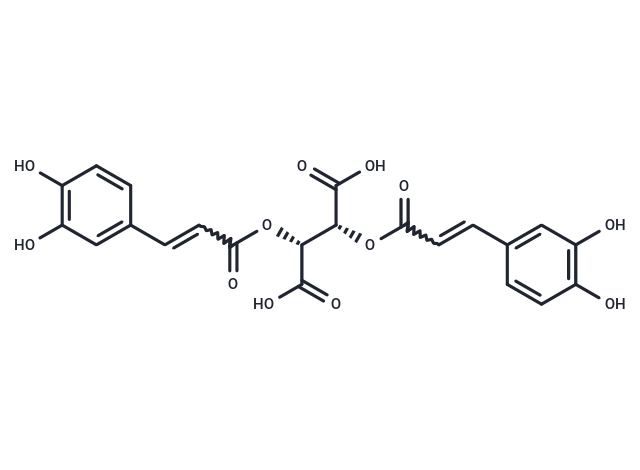Shopping Cart
Remove All Your shopping cart is currently empty
Your shopping cart is currently empty
Cichoric Acid (Dicaffeoyltartaric acid) is a potent inhibitor of human immunodeficiency virus type-1 (HIV-1) integrase and the replication in tissues. It also a class of cannabinomimetics with CB2 receptor-dependent and independent.

| Pack Size | Price | USA Warehouse | Global Warehouse | Quantity |
|---|---|---|---|---|
| 5 mg | $35 | In Stock | In Stock | |
| 10 mg | $57 | In Stock | In Stock | |
| 25 mg | $117 | In Stock | In Stock | |
| 50 mg | $198 | In Stock | In Stock | |
| 100 mg | $297 | In Stock | In Stock |
| Description | Cichoric Acid (Dicaffeoyltartaric acid) is a potent inhibitor of human immunodeficiency virus type-1 (HIV-1) integrase and the replication in tissues. It also a class of cannabinomimetics with CB2 receptor-dependent and independent. |
| Targets&IC50 | HIV-1 integrase:0.8 μM |
| Synonyms | Dicaffeoyltartaric acid, Chicoric Acid |
| Molecular Weight | 474.37 |
| Formula | C22H18O12 |
| Cas No. | 6537-80-0 |
| Smiles | [C@H]([C@@H](OC(C=CC1=CC(O)=C(O)C=C1)=O)C(O)=O)(OC(C=CC2=CC(O)=C(O)C=C2)=O)C(O)=O |
| Relative Density. | 1.641 g/cm3 (Predicted) |
| Color | White |
| Appearance | Solid |
| Storage | store at low temperature,keep away from moisture | Powder: -20°C for 3 years | In solvent: -80°C for 1 year | Shipping with blue ice/Shipping at ambient temperature. | ||||||||||||||||||||||||||||||||||||||||
| Solubility Information | H2O: 5 mg/mL (10.54 mM), Sonication is recommended. DMSO: 347 mg/mL (731.5 mM), Sonication is recommended. | ||||||||||||||||||||||||||||||||||||||||
| In Vivo Formulation | 50% PEG300+50% Saline: 10 mg/mL (21.08 mM) Please add the solvents sequentially, clarifying the solution as much as possible before adding the next one. Dissolve by heating and/or sonication if necessary. Working solution is recommended to be prepared and used immediately. The formulation provided above is for reference purposes only. In vivo formulations may vary and should be modified based on specific experimental conditions. | ||||||||||||||||||||||||||||||||||||||||
Solution Preparation Table | |||||||||||||||||||||||||||||||||||||||||
H2O/DMSO
DMSO
| |||||||||||||||||||||||||||||||||||||||||
| Size | Quantity | Unit Price | Amount | Operation |
|---|

Copyright © 2015-2026 TargetMol Chemicals Inc. All Rights Reserved.